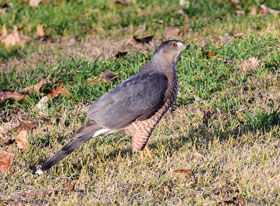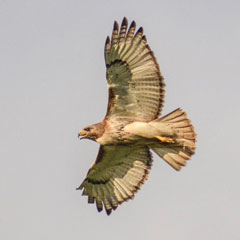
Cooper's Hawk (Accipiter cooperii)/ Photo taken by Mary Adams Bellegante
General Characteristics
Hawks have very broad, rounded wings and a short, wide tail. They often soar without flapping their wings.
Food Habits
Hawks will eat mice, rats, voles, rabbits, squirrels, pheasants, starlings, pigeons, blackbirds, snakes, and carrion. Depredation problems include the loss of:
- rabbits at beagle clubs
- homing and racing pigeons
- free-ranging farm poultry
- small household pets
- songbirds that are attracted to bird feeders.
Distribution and Abundance
Hawks occupy just about every type of habitat in Indiana from grasslands and fields to forests and wetlands. Even urban and suburban roadsides, parks, and cemeteries are home to hawks.

Red-tailed Hawk (Buteo jamaicensis) in flight/ Photo taken by J. Emmack
Reproduction
It varies across the different species of hawks, but in most, the male and female work together to build the nest and raise the young. The nest is built from scratch or one of the nests they’ve used in previous years is reused. Nests are generally made with sticks and lined with softer plant material. Hawks build their nests in trees normally, but sometimes use cliff ledges or artificial structures such as window ledges.
Prevention and Control
Exclusion
Many problems can be eliminated by simply housing free-roaming poultry in a coop or fenced enclosure. Chicken wire, nylon netting, or snow fencing can be used for this purpose.
Hawks that roost inside a building should be scared off with harassment techniques. Then close off all entrances to prevent the birds from re-entering.
Habitat Modification
Habitat modification can make an area less attractive to hawks. Remove lone trees or poles within 100 yards of the threatened area. Cap poles with sheet metal cones, Nixalite®, Cat Claws®, or inverted spikes. These changes may prevent hawks from perching in the area.
Improve rabbit and quail escape cover by constructing brush piles and planting shrubs. Edge feathering along woods can encourage brambles and brush to grow which improves cover. Hunt clubs should release only as many quail and pheasants that are needed for the outing.
If the presence of hawks around bird feeders is upsetting to a homeowner then the bird feeders should be taken down until the hawk has moved on. Typically in the winter, a hawk will only stay in an area for two or three weeks before moving on. Remember that this type of predation is natural and should be viewed as a learning experience to the observer who chooses to leave the bird feeder out.
Harassment Techniques
Visual scare devices such as pie tins hung in trees, Mylar scare tape, scarecrows, and eye-spot balloons may help move hawks to another location, though the relief may be only temporary. Lasers can be pointed a couple of feet in front of the bird and moved toward them. Lasers have been proven to work well in low light situations.
Audio scare devices include pyrotechnics such as cracker shells, bird bangers, blanks, propane cannons, and/or firecrackers.
Lethal Control
Hawks are regulated by state and federal laws which prevent the capture, killing, or possession of hawks without a special permit. Lethal strategies require a permit and should be undertaken with the guidance of the U.S. Department of Agriculture’s Wildlife Services Agency. No permits are required to scare depredating migratory birds except for endangered or threatened species.
Disease Threat
Some hawks have been found to carry West Nile Virus.
